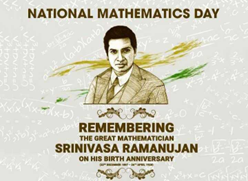PREVIOUS
National Mathematics Day – December 22
December 25 , 2022
854 days
504
0
- It is marked to recognise and celebrate the works of Srinivasa Ramanujan.
- He was born on this day in 1887 in Tamil Nadu’s Erode.
- The day was announced by the then Prime Minister Manmohan Singh to mark the 125th anniversary of the birth of this mathematical genius in 2012.
- 2012 was also observed as National Mathematics Year.
- He had developed a liking for mathematics at a very young age, mastering trigonometry at 12.
- Ramanujan was elected to the London Mathematical Society in 1917.
- Next year, he was elected to the prestigious Royal Society for his research on Elliptic Functions and theory of numbers.
- He was also the first Indian to be elected a Fellow of the Trinity College.
- His areas of work include infinite series, continued fractions, number theory and mathematical analysis, despite not receiving any formal training in pure maths.
- He also made notable contributions like the hypergeometric series, the Riemann series, the elliptic integrals, the theory of divergent series, and the functional equations of the zeta function.
- His biography ‘The Man Who Knew Infinity’ by Robert Kanigel depicts his life and journey to fame.
- 1729 is called Ramanujan number.
- It is the smallest number expressible as the sum of two cubes in two different ways.
- Because of this incident, 1729 is now known as the Ramanujan-Hardy number.

Leave a Reply
Your Comment is awaiting moderation.


